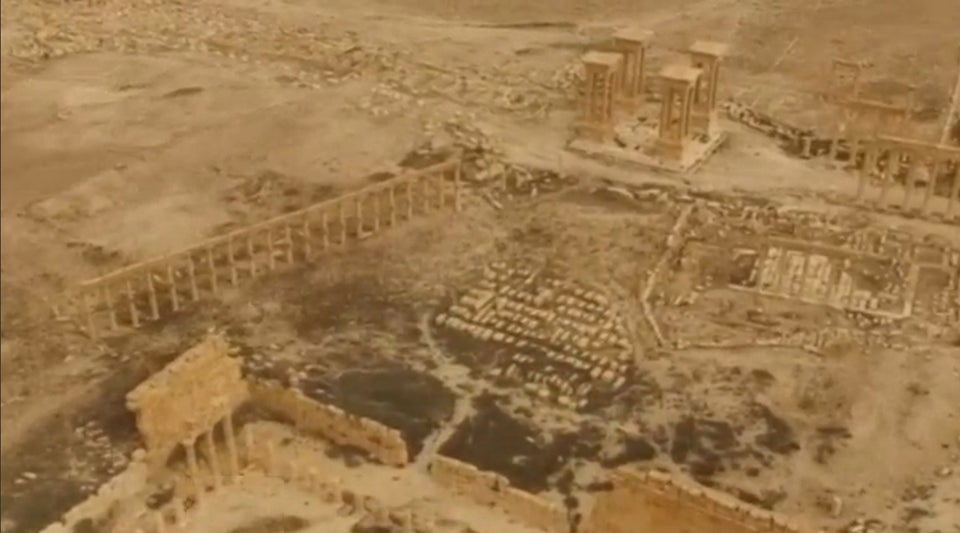The cinematographic prowess of the so-called Islamic State is, by now, well-known, admired, analyzed and even mocked. The films are so good, in fact, that the U.S. government's efforts to release anti-ISIS propaganda have sort of floundered.
Against this backdrop, the Department of Defense last year funded several studies through its Minerva Initiative for social science research that examine the phenomenon of extremist propaganda.
One of the studies conjectures that the reason ISIS videos are so effective is they use the tropes of Hollywood blockbusters -- particularly movies with "heroic quests" -- to appeal to would-be extremists.
The "Social and Neurological Construction of Martyrdom Project," directed by University of Chicago professor Robert Pape, received $3.4 million from the DOD to scan people's brains as they watch ISIS recruitment videos.

Pape thinks the heroic narrative of modern-day ISIS videos is a stark contrast to the grainy, single-camera screeds of previous groups like al Qaeda (think: Osama bin Laden speaking to a camera).
His lab will scan subjects with FMRIs as they watch ISIS films to determine what specific parts of the films elicit the greatest brain activity. This, he thinks, is the key to unlocking the power of these videos -- and to countering them.
"ISIS doesn’t just have better camera and techniques; they’ve adopted a heroic narrative that comes specifically out of Hollywood screenwriters," Pape told The Huffington Post. "This narrative is emotionally arousing and resonant, which can be a powerful motivator for young, would-be radicals."
He thinks this story structure may also affect specific brain regions like the amygdala, two almond-shaped areas that are key to emotional processing. Previous research has shown that the human brain is hardwired for storytelling and to respond to narratives. The control group in the study, which commences this fall, will be shown soothing videos like a nature documentary.
The 'Hollywood Formula'
Pape says ISIS videos closely mirror the 12-step narrative outlined in the popular 2007 screenwriting manual The Writer's Journey The manual is itself based on the work of mythologist Joseph Campbell, who proposed an archetypal "hero's journey" that is common to myths, stories and folktales from around the world.
Pape thinks this playbook can be seen as a direct blueprint for ISIS, which makes longer, feature-length films, in contrast to the short videos of its predecessors like al Qaeda.
"Step by step, pace by pace, Hollywood has been using this formula to put millions and millions of viewers into seats," said Pape. "And now ISIS is doing the same."
Christopher Vogler, author of The Writer's Journey, doesn’t think ISIS is taking his 12 steps quite so literally.
"ISIS is in the same media soup as anybody else in the world, and anybody who wants to portray their own group as heroic is going to -- without even thinking about it -- duplicate that pattern," he said.
Jeffry Halverson, an Islamic studies professor at Coastal Carolina University, said jihadist propaganda has always relied on "culturally-embedded master narratives.”
"The difference now is that ISIS is co-opting pop culture to appeal to youth, who might be swayed by promises of excitement and adventure more than condemnations of tyranny and heresy."
He says this differentiates ISIS from groups like al Qaeda, which used more "traditional," less relatable stock figures like martyrs and tyrants instead of adventurous heroes. For instance, al Qaeda often invoked the story of "Moses confronting the idolatrous tyrant Pharaoh for disobeying God," says Halverson, like in a 2002 statement that dubbed George W. Bush "the pharaoh of this age."
Turning the message around
Pape is not the first to try and pin down the appeal of ISIS videos through analogy. Javier Lesaca, an expert with the International Observatory for Terrorism Studies, has said ISIS deliberately mimics the look of video games like "Call of Duty" and "Grand Theft Auto" to appeal to young men.
But understanding how ISIS videos work may have limited use in isolation.
"We've known for at least three years now that these videos work," says Pete Hatemi, a political science professor at Penn State. "What should be our counter-strategy? That’s the real question."
Hatemi says the films are just one example that terrorists can subvert any medium for their own use. "Terrorists' most effective weapon against democracy is our own media," he said. "We have news services, and they make headlines." So as we watch blockbuster movies, they make recruitment films.
Pape thinks the insights from his study will help the U.S. make better anti-ISIS videos.
"Their effort isn't working because they fail to engage viewers' emotions the way ISIS videos do," says Pape. He suggests the government adopt its own "heroic logic" to counter the vision of ISIS.
"Countering the ISIS hero metric would involve emphasizing that the individuals in ISIS are not working for the community and are not patriots, but they are, instead, individually motivated, and should be seen as foreign occupiers whose desires are at odds with the local community," he suggested.
Hatemi, on the other hand, thinks it doesn’t need to be that hard.
"We could also just pick up what ISIS leaves out," he said. "They don't show the beatings, torture, rations, and terrible living conditions in an ISIS propaganda film. If we showed that, it could be half the battle."

